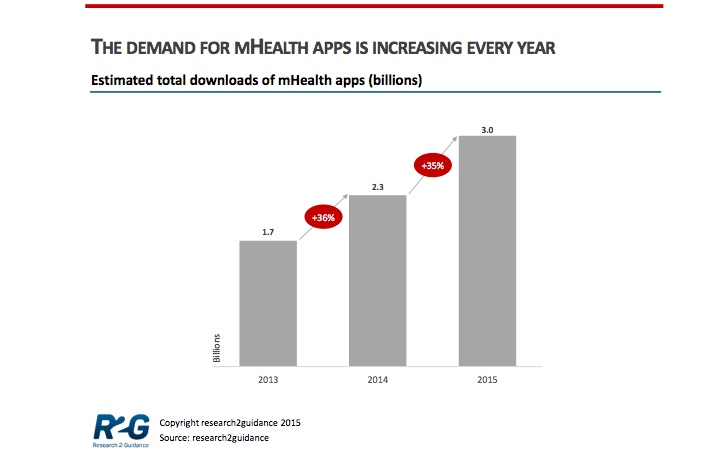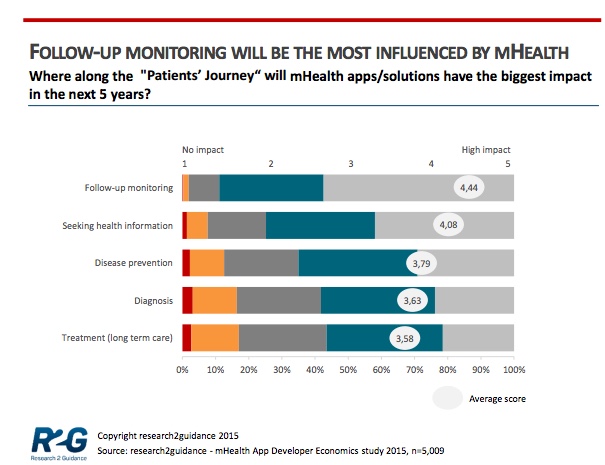Consumer demand for mHealth apps is booming across the globe, with recent data from Mobile Health Economics’ 2015 survey demonstrating yearly downloads in the billions, at least for Google Play and Apple. Yet, while the opportunity to improve healthcare accessibility and reduce costs is seductive, perception is not always reality and accordingly, patient journey needs are not being adequately addressed.

Demand aside, the mHealth industry continues to struggle to translate downloads to loyalty and overall utility. Direct application programming interfaces (APIs, e.g. MyFitnessPal), Sensor APIs (e.g. Fitbit, which collects data from a stand alone sensor) and data aggregators (e.g. Apple HealthKit) allow for easy sharing of health and fitness data between apps and undoubtedly will help move consumer experience to the forefront. The question remains, however, what else needs to be done?
Identifying key touch points of the customer journey and how it impacts offerings are integral to content strategy. Experts believe that mHealth will significantly influence what is considered a normal patient journey, the trajectory of which goes from seeking healthcare information to disease prevention to actually engaging and integrating treatment. The study data suggest that as many as 60% of practitioners consider follow up monitoring to be the most promising way to seamlessly integrate mHealth apps into treatment, and may even bypass legal restrictions on remote or virtual consultations and monitoring that exist in certain countries. Health-seeking information is the second-most impacted patient journey touchpoint, providing the option to streamline access to information on conditions, treatment or physician information at an instant. Both of these provide important opportunities for how, what and when patients and providers need information and can shape content strategy along with app development and optimization.

The good news is that for an industry that has been highly mired in tech, organizations are starting to embrace the need for medical expertise; today, roughly 6% of app publishers currently consult with medical professionals and at least 51% have them as part of their team. Let’s face it,without physician recommendation and encouragement, mHealth app downloads may not translate into usage and without usage, apps will continue to rot away on the App Store virtual shelves. However, security continues to take a backseat. Arxan Technology’s newly released State of Application Security Report – Healthcare Edition shows some troubling findings in that regard:
- Not only are healthcare organizations top targets of hackers seeking patient and health data/intellectual property, but 84% of cyber attacks occur at the application layer.
- Both consumers and IT decision makers by and large believe that their mHealth apps offer adequate protection against loss of information.
- Based on criteria by the Open Web Application Security Project (OWASP) Ten Top Mobile Risks, most health apps have significant vulnerabilities, including unintended data leakage, client side malware, security decisions based on inputs deemed untrustworthy and encryption issues. More troubling is the fact that the tested apps were approved by either the FDA or the NHS and 84% and 80%, respectively, did not adequately address at least two of the OWASP Top 10 mobile risks.
The upshot is that many companies are not adequately investing in security and the end-user patient journey will be significantly impacted. Arxan reports that even in lieu of a direct cyber attack, roughly 80% of app users would change providers if said provider had a known vulnerability or if an alternative offered greater security. Talk about disruption!
As R2G says, “the mHealth market is still in the hype phase and mainly technology and patient driven. Healthcare integration needs to take place before mHealth promises can materialize.”
If you wish doctors to come to the app table, you need to provide better security and plug the vulnerability holes. That’s today’s mHealth app reality.

